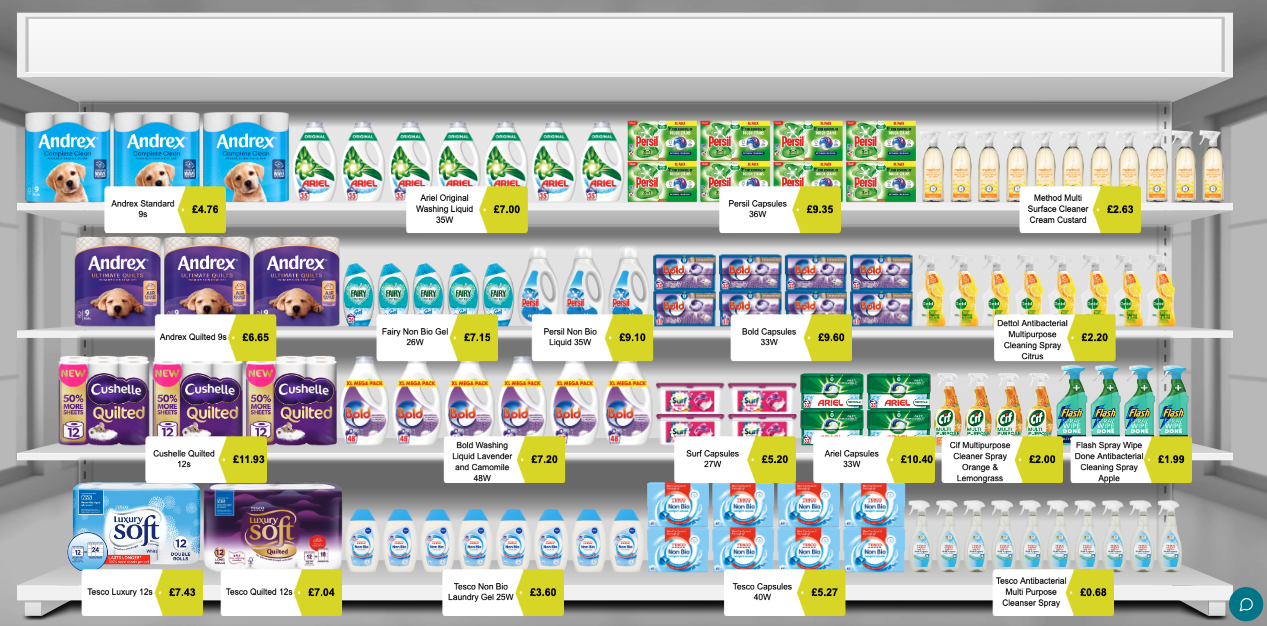Conjoint Analysis in FMCG Wargaming: The Strategic Chess Game Where You Know Your Competitor’s Next Move

In the fast-moving consumer goods (FMCG) sector, where competition is fierce and consumer preferences constantly shift, businesses are perpetually engaged in a strategic dance to stay ahead. Most of the time, the demands of internal reporting and analysis can mean reacting to competitor moves is more likely than proactive planning. Conjoint analysis, a powerful tool for understanding consumer preferences, has emerged as a key tool in helping companies model real-world decisions and can be a game-changer.
That’s a big claim, right? Let’s put it in the context of a game of chess. You sit down to face your stone-faced opponent only this is no ordinary game of chess as you have one crucial advantage: you already know your competitor's next moves. In FMCG, one wrong pricing decision or product feature can set your brand back 5% of market share. Or, if you are attempting to scale up your brand, the same unfortunate decision might create a glass ceiling to the progress of your business. So, the stakes are high but still, there is little evidence of significant proactive wargaming being given more than lip service in the major multinationals.
The ability to anticipate competitor strategies and understand consumer reactions is akin to mastering a chessboard with foresight. This article delves into how conjoint analysis in FMCG wargaming provides businesses with the tactical insight to make informed, competitive decisions, and why it feels like you're playing chess with a significant upper hand.

Understanding Conjoint Analysis: The Chessboard of Consumer Preferences
Before diving into how conjoint analysis enhances wargaming in FMCG, it's important to understand what conjoint analysis is and why it can be the differentiator in wargaming.
Conjoint analysis is a type of econometrics used to understand how consumers value different attributes that make up a product or service. These attributes could range from price, brand, and packaging to product features like ingredients, size, or even sustainability. Conjoint analysis allows companies to break down a product into its individual components and see which aspects hold the most value or utility for the consumer.
When applied to pricing or product development strategies, it provides transparency into what drives consumer choice. More importantly, it models how consumers would respond to changes in the product’s features, allowing businesses to forecast the potential impact of adjustments.
In chess, each piece has a different function and value. Some players may favour using their queen aggressively, while others prefer to carefully position their knights and bishops. Similarly, in the FMCG world, a company might tweak the price of its product, modify its packaging, or emphasize a new flavour to lure consumers. Conjoint analysis enables companies to map out these strategic moves in advance by testing how consumers react to various combinations of product attributes.
The beauty of conjoint analysis lies in its ability to simulate real-world decision-making scenarios. By understanding how consumers make trade-offs between attributes — like how a player sacrifices a knight to capture a queen — FMCG companies can make informed strategic moves that maximize consumer satisfaction and profitability.

FMCG Wargaming: The Battle of Strategies
In FMCG, where product cycles are short and competition is stiff, wargaming helps businesses anticipate the effects of price changes, new product launches, or shifts in consumer preferences, but it is usually only engaged when M&A activity highlights an impending change in the market or whispers of a disruptive innovation from a competitor is landing in the coming months. I remember the wargaming at Unilever when P&G were launching their new laundry platforms and when a board member moved from Unilever to head up a major retailer, but we rarely wargamed at annual planning.
In a typical wargame, companies analyze their competitors’ SWOTs. They simulate different market scenarios, predicting how competitors might react to their moves and testing their own strategies in a simulated environment. The goal of wargaming is to identify the best strategy (most profitable in the short term or long term) that will provide a competitive edge or minimise the edge a competitor is trying to establish.
However, traditional wargaming has a limitation: it often relies on past data and relies heavily on assumptions about consumer behaviours. This is where conjoint analysis elevates the game. Using Conjoint tools, companies can simulate how consumers will react to their competitors' moves as well as their own strategy.
Conjoint Analysis in FMCG Wargaming: Knowing Your Competitor’s Next Move
Imagine playing chess where you can anticipate your opponent's next five moves. You know when they're about to move their queen, advance their pawns, or position their rooks for a checkmate. This level of foresight gives you the ability to plan your strategy with precision, allowing you to stay several steps ahead.

Example: Persil increasing prices of their capsules
In this example, Persil could predict using standard long-term elasticities what might happen to their volumes. The Bold team at P&G could also use their EPOS tools to predict the increase, but most likely all are using the assumption of linear elasticities and so it is a little bit of a white-knuckle ride until the first set of Nielsen data arrives proving the assumptions were right.
Instead, if the Bold team could use a Conjoint to simulate each scenario, it would quickly identify the optimal price increase to take on their own brand to ensure they do not lose margin or value share for another quarter.

The Consumer’s Role: Pawns on the Chessboard
In any wargame, whether it’s a chess match or an FMCG market simulation, the consumers are the pawns. They may not have the same power as the rooks, knights, or queens, but they play a crucial role in determining the outcome. The difference is that in FMCG wargaming, the pawns have their own preferences, desires, and constraints. These preferences may not follow the rational response to changes in the choices because they are not all “Econs” (Richard Thaler & Daniel Kahneman), the rational individual who weighs up all possible choices and makes logical steps forward, but they are “Human” who can be emotional, erratic, irrational but is very well versed in post rationalising their decisions and choices. Something that micro economists have always struggled with.
Just having historical sales data as the guide for what would happen next means you are aggregating all these erratic behaviours into smooth averages. So, when you hit a key price point, or move beyond a key threshold for specific segments, the impact will be disguised or muffled and effectively misunderstood. Conjoint analysis on the other hand seeks to understand all of the respondent behaviours and allows them to respond in their unique way to changes you add to the market place.

Price Elasticity by segment - Weekly Grocery Spend (Persil Capsules 33w)
Now that you know how the individuals in the market behave and you know what is valued by them, you can design products, improvements or price changes to existing ranges that your customers will respond to. In chess, it’s the same as knowing how your opponent values their pawns, which can help you anticipate their expected moves.
The Dynamic Nature of FMCG Wargaming
One of the key challenges in FMCG is that consumer preferences and market conditions are constantly changing. New trends emerge, competitors launch new products, and external factors like economic downturns or supply chain disruptions can have a significant impact on the market.
Conjoint analysis is particularly valuable in this dynamic environment because it allows companies to continuously update the market conditions (increasing / decreasing prices). Similarly, with the likes of supply chain disruption or retailer delists, if you have a conjoint analysis that was conducted in the last six months you can easily use it to quickly model the new world scenario, giving you the understanding of the substitution within brand, switching to competitors and exits from the category.
For more advanced tracking, conducting conjoint analysis surveys every six months and incorporating the data into wargaming exercises, FMCG companies can stay ahead of the competition by being able to identify changing behaviours and preferences first and then adapting their strategies in real time.
The Long-Term Benefits: Winning the Chess Match
In chess, the goal is to checkmate your opponent by strategically positioning your pieces and anticipating their moves. Similarly, in FMCG, the goal is to outmanoeuvre your competitors by making informed decisions that maximize market share and profitability.
As Simon Sinek highlights in his book the “Infinite Game”, industries like FMCG usually have some well-funded competitors who will lose share but are not at risk of going out of business because of a poorly executed packaging or price change, so a killer blow is rarely landed. They are playing a much longer game, with many rounds. Therefore, landing some bruising hits on your competitor, and creating some clear blue water between you and them is the objective. Conjoint analysis provides these companies with the insights they need to create that distance by simply understanding what consumers value most.

Conclusion: Playing Chess with Foresight
FMCG, where competition is fierce and consumer preferences are evolving, companies need every advantage they can get. Conjoint analysis, when applied to wargaming, provides businesses with a strategic edge by allowing them to anticipate both consumer reactions and competitor moves. Like playing chess, but with the added advantage of knowing your opponent’s next move. This foresight allows companies to make smarter, more informed decisions that maximize their chances of success in a competitive marketplace.


